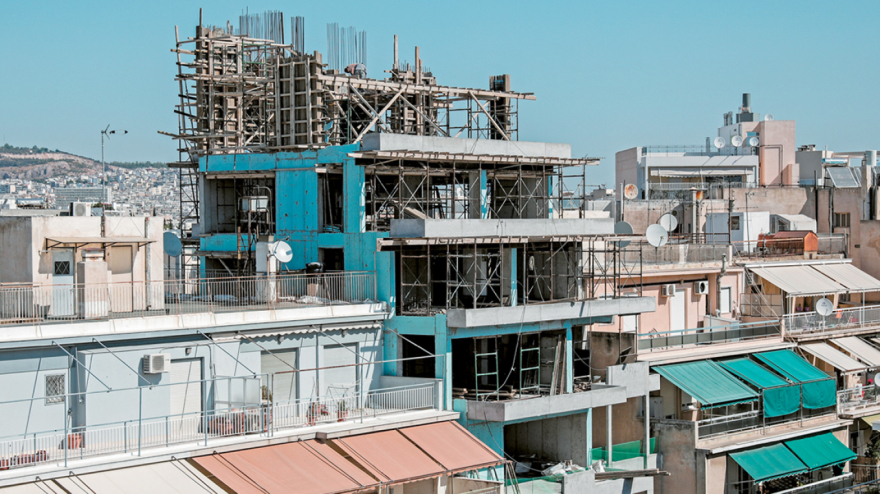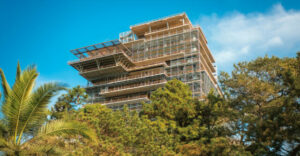A temporary freeze on constructions using the bonuses of the New Building Code (NBC) until the Council of State decision is issued is being implemented by most municipalities in Attica, cancelling concrete skyscrapers in the city’s most expensive suburbs and the arbitrary actions of developers with the blessing of the NBC.
The safety net has also been covering the Municipality of Athens since last week, after a unanimous decision by the city council decided to suspend building permits for two years until the urban planning is completed, in an effort by the country’s largest municipality to protect citizens from the fait accompli that a negative ruling by the State Council could create.
Added to the wall that the municipalities of Attica have erected in recent days was a new decision by the E Chamber of the State Council, issued after an appeal by the Municipality of Alimos, which also dismisses those who used the so-called “hidden coefficient”, the gift that the NBC gave them to exclude from the added building factor spaces such as lofts and bay windows, so that the square meters are increased and the buildings are enlarged.
The Municipality of Alimos along with the Municipality of Vari-Voulas-Vouliagmeni, who spearheaded the demolition of the NBC, continue to feed the news around the stormy developments

The protection of gardens
Until the relevant decision is issued, Mayor of Kifissia Vassilis Xypolytas tells “THEMA” that the municipality will continue to issue permits based on the modified framework of the Ministry of Environment and Energy, as it was presented in the spring, with the aim of intervening in the building megastructures and correcting the bad texts of the NBC. “Up to 0.8 factor, which is 80% of the city, no height is given, from 0.8 and above 2 meters are given, and as far as Nea Erythraia is concerned I am trying to get ‘injunctions’ for it as well,” says Xypolitas.
However, he clarifies that the heights of the buildings are not the only reason why Kifissia is reacting. The municipality of the northern suburbs, with its aristocratic residences and large gardens, is seeking to address the aftermath of the NBC in terms of land coverage issues as well.

The New Building Regulations allow basements to be built outside the building’s perimeter, meaning basements can be extended over most of the plot, over an area of almost more than 80% of it. In fact, if the plot is small, i.e. has a surface area of up to 600 sq. m., basements can occupy the entire plot, leaving little or no space for tree planting.
This development, according to Mr. Xypolyta, will lead to the end of the gardens of Kifisia and the obvious reason is because the roof of the basements is inhospitable to large vegetation and trees as only shrubs and lawns can be planted there. Therefore the construction of a building therefore brings about a painful environmental “shaving” of the plots making the residential environment more difficult.
The mayor of Kifissia argues that many century-old trees are being cut down and residents find it difficult to react, since their cutting is legal since it is provided for in the building permits that have been issued. According to reports, the Ministry of Environment is working on a regulation to ensure that building in peri-urban areas and garden cities is not to the detriment of the environment and greenery.
So, limit provisions that only make sense and apply to city centers and dense neighbourhoods choked by cars. The problem with the gardens is also pointed out by the mayor of 3B Grigoris Konstantellos, saying it is an issue that the Central Union of Greek Municipalities (KEDE) has also raised, but there is no provision in the law to date.

As for the more general issues of the NBC, the mayor of the southern suburbs stresses that all those affected by the building behemoths are waiting for the decision of the State Council, which will be heard on October 13. However, the relevant decision is not expected to be issued before March 2025 and until then building activity is expected to continue to be subject to severe restrictions.
As Constantellos says, if a municipality has ten-storey buildings, the NBC makes no real difference to it. But in the municipalities of the southern suburbs, where the buildings are five stories high from three, and with a 30% increase in the building factor, the difference is great.

The Municipality of Athens
The Municipality of Athens is also taking a step forward, which has begun the study for the new urban plan by reviewing heights and building factors. “Due to the serious urban planning importance of the issue, combined with the time-consuming procedures governing the preparation of the study of the Local Urban Plan and in order to prevent phenomena that will constitute an inhibiting factor in the drawing of conclusions, it is imperative to immediately promote the imposition of a partial suspension of the granting of building permits for two years,” noted the recent recommendation of Deputy Mayor Maro Evaggelidou to the city council.
The suspension of building permits will apply to the current maximum permissible heights that exceed those stipulated in the royal decree of 1955, the building bonuses on the heights and volume of buildings stipulated in the NBC, and the current building coefficients that are higher than the average building coefficients stipulated in the General Urban Plan of the Municipality of Athens, excluding the areas of the municipality that are governed by special protection decrees.
In her presentation, the deputy mayor clarifies that the universal suspension of building permits is not proposed in order not to completely stop construction activity and to limit the impact on the economy. As noted, the partial suspension can act as a safety net against phenomena of accelerated building before the institutionalization of urban planning in order to take advantage of the favorable regulations that multiply the square meters.
The increase in building that the combination of height and increased building rates has brought about in Athens will be reviewed during the preparation of the study of the new urban plan for the capital city, as it has led to the energy burden, the shrinkage of available public and common spaces, the exceeding of the carrying capacity of the infrastructure and the alteration of the character of certain neighbourhoods.
Photo: Shutterstock
Ask me anything
Explore related questions





